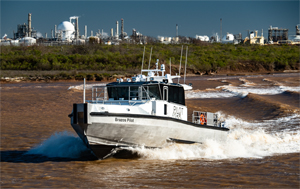On a late January run out to the containership Bomar Resolute, anchored near the Freeport, Texas, sea buoy, the recently delivered Brazos Pilot was bucking a 6-to-8-foot sea. A strong north wind had extended the effects of a thermal grip across the Mason-Dixon Line to the Gulf of Mexico.
Jack Stanley, the operator of the 64-foot newbuild, said that in the past local mariners would have relied on the 36-year-old Freeport Pilot in similar sea conditions. “But it would have been a lot slower,” he said.
Capt. Billy Burns, president of the Brazos Pilots Association, explained the motivation for acquiring the new Defiant-class pilot boat, designed and built by Metal Shark at its Franklin, La., shipyard.
“We started with the question, ‘How do we bring oil, car carriers, containers, whatever, into Texas waters safely for the cargo, the mariners and the environment?’” he said. “That’s job safety. Then there is the personal safety of the boat operators and pilots.”
Transferring a pilot with the 45-foot single-screw Freeport Pilot, with less than 400 horsepower, was accomplished at 6 knots. The 1,606-hp Brazos Pilot performs the operation at 10 knots.
The new boat is 19 feet longer, 6 feet wider and three times heavier than Freeport Pilot, improving stability and seaworthiness. The increase in speed adds a degree of safety when transferring pilots on and off larger, faster ships. A higher gunwale can take on bigger seas, and the boarding platform is raised from the foredeck by 3 feet to get the pilot up and out of the spray during transfers.
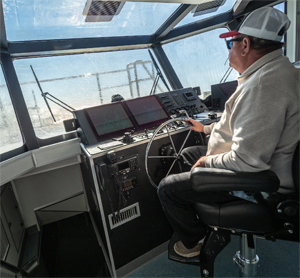 |
|
Jack Stanley mans the helm in Brazos Pilot’s wheelhouse. Skylights provide a direct sight line to the pilot ladder during personnel transfers. |
Burns said that the boarding platform was fitted at the pivot point of the boat, just ahead of the pilothouse, the closest and safest transfer point against a ship’s hull.
Even though the twin C18 Caterpillar mains can propel Brazos Pilot at 28 knots, the boat was designed for power, not speed.
“Although (speed is) nice to have, our real design criterion was the ability of the boat to break powerful suctions that large ships generate near their stern,” Burns said. “Many pilot boats have been sunk because they lacked the power to break away.”
The large wheelhouse provides 360-degree visibility and is fitted with skylights for a direct line of sight to the pilot ladder. Metal Shark installed its signature “pillarless glass” and reverse-raked windows to minimize glare and improve visibility.
A gyrostabilized FLIR camera system was installed for night operations. Utilizing thermal signatures, the system identifies objects and people in the water, allowing for avoidance and rescue, respectively.
“The boat’s seaworthiness is a big improvement,” Stanley said. “It’s a bigger, heavier boat than the previous one. It also has more freeboard and the visibility is tremendous.”
“To compare the two boats is like comparing a 1920 Ford Model T with a 2019 Ford F-250,” Burns said.
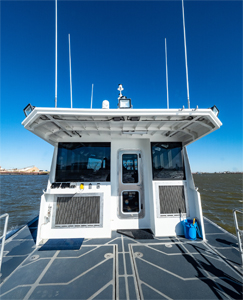 |
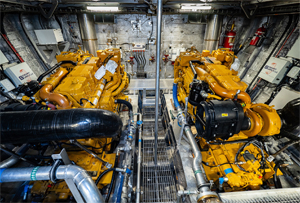 |
|
|
The control station on the aft deck is tucked under the extended wheelhouse roof to keep the operator out of the weather. |
The launch’s twin Caterpillar C18 mains deliver speed and power to break stern suction when maneuvering alongside ships. |
|
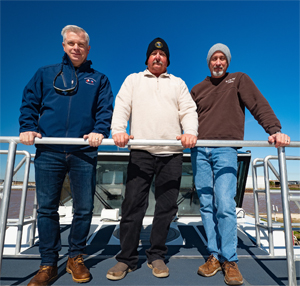 |
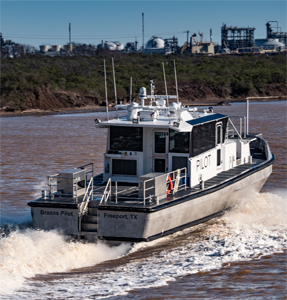 |
|
|
Capt. Billy Burns, president of the Brazos Pilots Association, stands on the boat’s boarding platform with operators Jack Stanley, center, and John Roach. |
Brazos Pilot is 6 feet wider than Freeport Pilot, giving the newcomer added stability. Twin Disc gears transfer power though a pair of Michigan Wheel props. |
Brazos Pilot specifications |
|
Owner/operator: Brazos Pilots Association, Freeport, Texas |
|
PROPULSION CAPACITIES NAVIGATION/COMMUNICATIONS ADDITIONAL EQUIPMENT |

